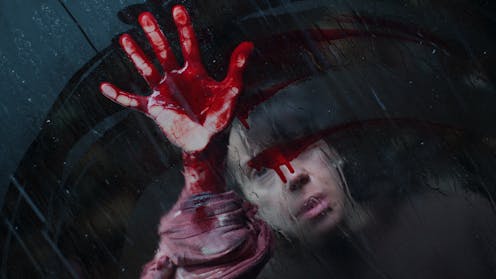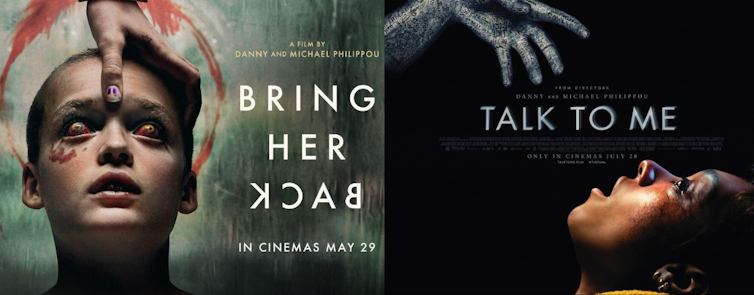Detta inlägg post publicerades ursprungligen på denna sida this site ;
Date:
Author: Jessica Balanzategui, Associate Professor in Media, RMIT University
Original article: https://theconversation.com/talk-to-me-was-a-rollercoaster-but-the-philippou-brothers-bring-her-back-will-trap-you-in-a-house-of-horrors-257631

They may have only made two feature films so far, but Danny and Michael Philippou are already being hailed as Australia’s premiere horror auteurs.
Their 2023 debut Talk To Me sparked a bidding war between distributors upon its premiere at Sundance.
It went on to become prestige indie studio A24’s highest grossing horror release ever at the United States box office. That’s an impressive feat, given A24 is behind some of the most revered horror films of the 21st century, including Ari Aster’s Hereditary (2018) and Midsommar (2019), and Robert Eggers’ The Witch (2015).
This context helps explain the sky-high expectations around the release of the Philippous’ newest horror film, Bring Her Back. The brothers even expressed their nerves around the film’s release during a preview screening introduction.
But I’d suggest they breathe a sigh of relief. Bring Her Back trades the chaotic thrills of Talk To Me for a slow-burning, sensory-driven exploration of grief that’s as engrossing as it is unbearable.
Same universe, but not a sequel
Bring Her Back is very tonally distinct from and not explicitly narratively linked to Talk To Me. However, the directors have explained it exists in the same fictional universe as their original smash hit.
This explains why, despite the stark difference in tone – Bring Her Back is a much more sombre watch – there are many thematic and stylistic parallels. These similarities are visible from the films’ marketing materials, through to individual frames.

A24
Bring Her Back’s sombre notes
Talk To Me is a riotous, bloody and loud racket of teen supernatural possession horror.
Like Richard Carter’s song Le Monde, a viral hit from the movie’s soundtrack, the film rises and falls cacophonously. It follows a group of teens at a party as they decide to commune with the dead through an occult party prop: a cursed hand.
Trauma, grief, gore and comedy strike discordantly at the piano keys as the body count piles up.
In contrast to Talk To Me’s tonal and sonic mayhem, Bring Her Back heavily pounds at the same two notes throughout: grief and trauma.
Set in the horror staple of a mysterious, suffocating house, the film follows step-siblings Piper (Sora Wong) and Andy (Billy Barratt) as they adjust to life with their new foster mother, Laura (Sally Hawkins), after their father’s sudden death. The teen’s sense of vulnerability in the strange new environment is heightened by the fact Piper is blind.
Bring Her Back builds on a trend of sensory-driven horror films – including the Quiet Place franchise, Bird Box (2018), and The Silence (2019) – that impel viewers to navigate threatening environments through the main character’s sensory loss or impairment.
Uncomfortable on the ear
In Bring Her Back, the viewer inhabits the destabilising environment of the house through layered sensory textures that feel increasingly claustrophobic and threatening.
Case in point is the harsh rush of water in the running shower where the teens find their father’s gruesome dead body in the opening moments. As the film progresses, this sound manifests as a genuine threat to Piper’s life, in the form of relentlessly pouring (and potentially occult) rain.
The oppressive rain gradually fills up the house’s desolate, unfenced swimming pool, which is the site of previous trauma for foster mother Laura.
Simply traversing the house’s backyard becomes increasingly perilous for Piper as she becomes accustomed to her environment, a process the audience shares through the audio-visuals of her hands gliding across walls, counter tops and corners.
The immersive sound design is dense with hands scraping, sliding and slapping – as well as some truly hideous teeth gnashing. These tactile sounds integrate chillingly with the otherwordly soundtrack composed by Cornel Wilczek, who also composed the score for Talk to Me.
Haunting performances
The teens soon learn that another foster child, the mute and mysterious Oliver (Jonah Wren Phillips), also inhabits the house. The strange relationship between Laura and Oliver couldn’t be more ominous.
Sally Hawkins is captivatingly monstrous as the outwardly warm but increasingly overbearing and unhinged mother figure (particularly for those of us with a fresh memory of Hawkins’ loveably zany mum, Mrs Brown, from the Paddington films).
Piper is tempted to sink into the warm embrace Laura offers. The viewer, however, is privy to Laura’s vicious streak – evident in her rough, uncaring gestures, harsh glares and sinister flashes of cunning.
Young Jonah Wren Phillips is transfixing as the creepy Oliver, delivering a performance through piercing stares and tortured bodily contortions rather than dialogue.
Unbearably grim
Bring Her Back exhibits a dense film literacy. The Philippous have discussed the influence of classic “psycho biddy” films such as What Ever Happened to Baby Jane? (1962), and foundational ghost films such as The Innocents (1961).
But for me, Bring Her Back chimes most evocatively with the trauma- and grief-soaked Japanese horror wave of the early 2000s, and particularly with Hideo Nakata’s J-Horror masterpiece Dark Water (2002).
This tragic ghost story similarly deploys the rippling, rushing and dripping of water as an agent of death and decay within fractured mother-daughter relationships.
Inhabiting the world of Bring Her Back ends up feeling like an unbearably grim and claustrophobic endurance effort – which is exactly what the Philippous intended.
While this is not the exhilarating rollercoaster of Talk To Me, the shift in tonal gears showcases the Philippous’ impressive range within the horror genre’s rich emotional terrain.
Bring Her Back is in cinemas from today.
![]()
Jessica Balanzategui receives funding from the Australian Research Council.